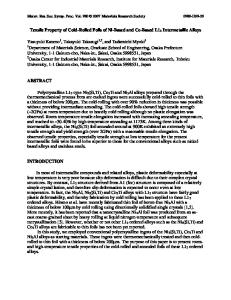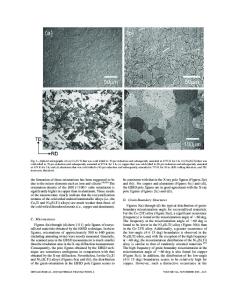The Effect of Dislocation Dissociation on Crack Tip Plasticity in L1 2 and B2 Intermetallic Alloys
- PDF / 485,266 Bytes
- 6 Pages / 420.48 x 639 pts Page_size
- 88 Downloads / 340 Views
THE EFFECT OF DISLOCATION DISSOCIATION ON CRACK TIP PLASTICITY IN L12 AND B2 INTERMETALLIC ALLOYS
MICHAEL F. BARTHOLOMEUSZ, WEIGANG MENG AND JOHN A. WERT Department of Materials Science and Engineering University of Virginia, Charlottesville, VA 22903 ABSTRACT Low toughness at ambient temperatures is an inherent problem in many ordered intermetallic alloys that otherwise have attractive properties for high temperature applications. One potential explanation of low toughness is the existence of an energy barrier for crack tip dislocation emission. A model describing the energy associated with emission of a dissociated superlattice dislocation from a crack tip in ordered intermetallic alloys has been formulated. Application of the model to a wide variety of intermetallic alloys with the Li 2 and B2 crystal structures has revealed a correlation between the observed macroscopic fracture mode and the calculated range of slip system orientations for which emission of a dissociated superlattice dislocation at ambient temperatures is possible. Additionally, the model has been used to predict the effects of lowering the stacking fault energy, increasing the thermal energy available for thermally activated dislocation emission, and changing the active slip system. Preliminary fractographic analyses have been conducted with a chromium-modified AI3 Ti alloy to verify the model predictions. 1
INTRODUCTION AND MODEL
Cleavage fracture in materials possessing a high critical resolved shear stress (CRSS) is relatively easy to understand: the high resistance to slip inhibits crack tip plasticity, resulting in cleavage fracture. However, many intermetallic alloys that fail by cleavage fracture possess low to moderate values of CRSS, requiring an alternate explanation for cleavage fracture. Rice and Thomson (RT) [1] proposed a model for cleavage fracture independent of CRSS in which the Griffith criterion is invoked to determine the critical remote stress required for cleavage fracture. The RT model proposes that cleavage fracture will not occur if it is energetically favorable for an atomistically sharp crack under mode I loading to emit a dislocation at the critical stress. However, if an energy barrier for dislocation emission exists at the crack tip, dislocation emission is inhibited resulting in cleavage fracture. Bartholomeusz and Wert (BW) [2, 3] extended the RT analysis to treat emission of dissociated superlattice dislocations from crack tips in L1 and B2 intermetallic alloys. The extended model can be used to examine the effects o temperature and variations of material properties on the emission of superlattice and dissociated superlattice dislocations from crack tips. For a detailed description of the mathematics of the model and a discussion of the material parameters selected, see Refs. [2, 3]. The purpose of the present paper is to describe model results, and place them in the context of available experimental results. In the case of a dissociated superlattice dislocation, the total energy of the dislocation as a func
Data Loading...











